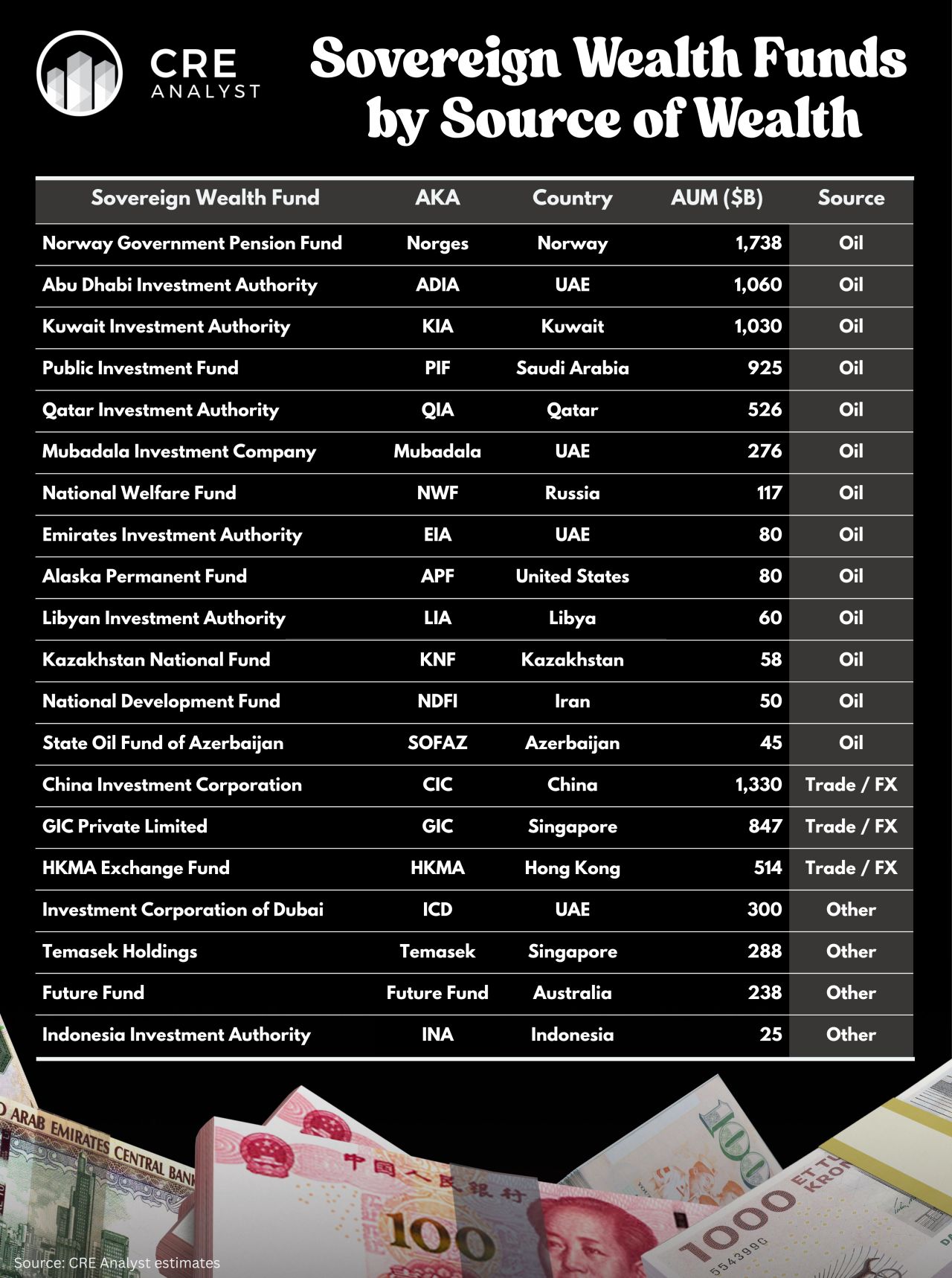
How are the largest investors in the world the least understood? A quick primer on “sovereign wealth.”
---- What is a sovereign wealth fund? ----
SWFs are state-owned investment funds that manage state reserves, typically originating from surplus revenues like oil and gas exports or foreign exchange reserves. SWFs invest globally across various asset classes to diversify and grow wealth for future generations or stabilize the economy against volatility.
---- Why are SWFs so meaningful? ----
Huge amounts of capital and growing in influence…
The largest 20 SWFs that we track manage nearly $10 trillion in assets.
Norges tops the list and is more than 3x the size of the largest U.S. pension fund (CalPERS).
Also, SWFs are positioned to grow in size and influence.
Most real estate players hadn't heard of SWFs 20 years ago, but they're increasingly becoming a primary investor type, particularly in the largest U.S. markets.
---- Sample SWFs ----
Norway Government Pension Fund Global (GPFG/Norges)
$1.7 trillion
China Investment Corporation (CIC)
$1.3 trillion
Abu Dhabi Investment Authority (ADIA)
$1.1 trillion
Kuwait Investment Authority (KIA)
$1.0 trillion
Public Investment Fund (PIF) (Saudi Arabia)
$925 billion
GIC (Singapore)
$847 billion
Qatar Investment Authority (QIA)
$526 billion
---- Source of wealth? ----
Although SWFs are big and complicated, most have an obvious advantage over other investors: oil and gas reserves.
Most SWF wealth comes from oil and gas reserves, which are monetized and invested, and
catching up to a SWF is a lot like trying to catch up to a Walmart heir. I.e., it’s probably not going to happen.
---- What is not a SWF? ----
Some people broaden the scope of SWFs to include public pension funds and central banks, but pure SWFs exist to manage and grow national wealth, not to enrich specific employees, manage currency/monetary policy, etc.
---- Does the U.S. have a SWF? ----
No. The U.S. doesn't accumulate large surplus revenues, but certain U.S. states, notably Alaska's Permanent Fund, invest revenues from oil production to benefit state residents directly. This state-level example resembles an SWF, but the U.S. lacks a national equivalent.
PS -- Something off? We've done our best aggregating this table for an upcoming book but welcome fact checking! Add your adjustment to the comments, and we'll send you a free copy of the book if your suggestion leads to a revision.
---- What is a sovereign wealth fund? ----
SWFs are state-owned investment funds that manage state reserves, typically originating from surplus revenues like oil and gas exports or foreign exchange reserves. SWFs invest globally across various asset classes to diversify and grow wealth for future generations or stabilize the economy against volatility.
---- Why are SWFs so meaningful? ----
Huge amounts of capital and growing in influence…
The largest 20 SWFs that we track manage nearly $10 trillion in assets.
Norges tops the list and is more than 3x the size of the largest U.S. pension fund (CalPERS).
Also, SWFs are positioned to grow in size and influence.
Most real estate players hadn't heard of SWFs 20 years ago, but they're increasingly becoming a primary investor type, particularly in the largest U.S. markets.
---- Sample SWFs ----
Norway Government Pension Fund Global (GPFG/Norges)
$1.7 trillion
China Investment Corporation (CIC)
$1.3 trillion
Abu Dhabi Investment Authority (ADIA)
$1.1 trillion
Kuwait Investment Authority (KIA)
$1.0 trillion
Public Investment Fund (PIF) (Saudi Arabia)
$925 billion
GIC (Singapore)
$847 billion
Qatar Investment Authority (QIA)
$526 billion
---- Source of wealth? ----
Although SWFs are big and complicated, most have an obvious advantage over other investors: oil and gas reserves.
Most SWF wealth comes from oil and gas reserves, which are monetized and invested, and
catching up to a SWF is a lot like trying to catch up to a Walmart heir. I.e., it’s probably not going to happen.
---- What is not a SWF? ----
Some people broaden the scope of SWFs to include public pension funds and central banks, but pure SWFs exist to manage and grow national wealth, not to enrich specific employees, manage currency/monetary policy, etc.
---- Does the U.S. have a SWF? ----
No. The U.S. doesn't accumulate large surplus revenues, but certain U.S. states, notably Alaska's Permanent Fund, invest revenues from oil production to benefit state residents directly. This state-level example resembles an SWF, but the U.S. lacks a national equivalent.
PS -- Something off? We've done our best aggregating this table for an upcoming book but welcome fact checking! Add your adjustment to the comments, and we'll send you a free copy of the book if your suggestion leads to a revision.

COMMENTS